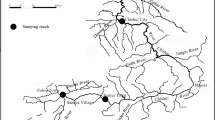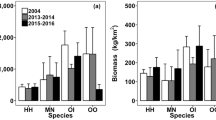Abstract
The tsunami following the Great East Japan Earthquake in March 2011 resulted in significant ground subsidence and deposition of rubble and mud in the Natori River, near the city of Sendai (Miyagi Prefecture), damaging its brackish water ecosystem and fishing grounds. There was a direct impact in the form of annihilation of animal and plant life and disturbance of the habitats throughout. Also, a wedge of seawater ran far upstream, and ground subsidence changed the pattern of tidal flow in the river. Brackish water ecosystems such as that near the mouth of the Natori River are important as nurseries for juvenile fishes and as a fishing ground for bivalves such as clams. The populations of both of these kinds of organism declined drastically as result of the tsunami. The catch per unit effort of ayu fish (sweetfish; Plecoglossus altivelis altivelis) in 2011 was the lowest recorded for the past 5 years, and the population hatching date composition showed a marked absence of early-hatched individuals. In contrast, the residual upstream ayu fish population seems to have grown successfully and reproduced despite the effects of the tsunami: 1 year after the tsunami occurred, the downstream ayu fish population had recovered to the same level as before the event. However, the population of the brackish-water clam, Corbicula japonica, only showed recovery 2 years after the disaster as its habitat has drastically shifted due to movement of the brackish water zone about 1 km upstream. The studies reported here show that the impact of the earthquake and tsunami on pelagic fish and benthic bivalves seems to have been quite different, as in the former recovery was rapid, while in the latter it took much longer. Many other fish species also returned to normal levels within a year, such as stone flounder (Kareius bicoloratus), goby (Acanthogobius lactipes), icefish (Salangichthys microdon) and black porgy (Acanthopagrus schlegelii). The food web structure appears to be slightly different from past years, but the results show that, in general, fish communities are able to recover rapidly from disturbances even as drastic as an unusually large tsunami.
Access this chapter
Tax calculation will be finalised at checkout
Purchases are for personal use only
Similar content being viewed by others
References
Deniro M, Epstein S (1978) Influence of diet on the distribution of carbon isotopes in animals. Geochim Cosmochim Acta 42:495–506
Deniro M, Epstein S (1981) Influence of diet on the distribution of nitrogen isotopes in animals. Geochim Cosmochim Acta 45:341–351
Fisheries Research Agency of Japan (2013) www.fra.affrc.go.jp/eq/repo_res/report01.pdf
France RL (1995) Carbon-13 enrichment in benthic compared to planktonic algae: food web implications. Mar Ecol Prog Ser 124:307–312
Fry B, Sherr E (1984) δ13C measurements as indicators of carbon flow in marine and freshwater ecosystem. Cortrib Mar Sci 27:13–47
Gambe S, Oota H, Suzuki N, Ito K, Sasaki K, Inomata K, Nakagawa R (2014) Presumption of sediment movement in Sendai Bay caused Pacific coast of Tohoku Earthquake Tsunami, according to comparison of C, N quantity and stable isotope ratio. Miyagi Pref Rep Fish Sci 14:1–10 (in Japanese)
Geospatial Information authority of Japan (2015) Data from basic reference points and observations from geodetic surveys. http://www.gsi.go.jp/kizyunten.html (in Japanese)
Goto T (2014) Stock size fluctuations of Japanese flounder, Paralichthys olivaceus, in the coastal waters off Iwate Prefecture after the Tohoku earthquake and tsunami disaster. Kaiyo Mon 46(11):12–20 (in Japanese)
Goto T, Omura T (2012) Effects of earthquake disaster with huge tsunami in March 2011 on marine environment and fishery resources in the coastal waters off Iwate, Pacific coast of northern Japan. Kaiyo Mon 44(6):328–335 (in Japanese)
Honda H, Katayama S, Ito K, Chida Y, Omori M, Okata A (1997) Structure and function of the production system in estuarine fish assemblage. Bull Coast Ocean 35:57–68 (in Japanese)
Ishida O, Ishii T (1972) Tolerance to salinity of Corbicula japonica and morphological differences by regions. Aquac 19:167–182 (in Japanese)
Ito K (2002) Carbon and nitrogen stable isotope ratios of planktonic and benthic diatoms. Jpn J Limnol 63:166–168 (in Japanese)
Ito K, Kakegawa T (2007) Food source for fishes in blackish water ecosystem. In: Tominaga O, Takagi N (eds) Discovery in aquatic animal ecology presented by stable isotope scope. Koseisha Koseikaku, Tokyo (in Japanese)
Katayama A, Ito K (2012) Distribution of the brackish-water clam Corbicula japonica in the Natori River after the Great East Japan Earthquake. Kaiyo Mon 44(6):314–320 (in Japanese)
Katayama A, Ito K (2014) Recovery of resources of Corbicula japonica in the Natori River after the Great East Japan Earthquake. Kaiyo Mon 46(11):31–38 (in Japanese)
Katayama A, Ito K, Sasaki K, Katayama S (2013) Carbon and nitrogen sources for the bivalve Corbicula japonica in Natori River estimated from stable isotope analyses. Nippon Suisan Gakkaishi 79(4):649–656 (in Japanese)
Kanaya G, Suzuki T, Maki H, Nakamura Y, Miyajima Y, Kikuchi E (2012) Effects of the 2011 Tsunami on the topography, vegetation, and macro benthic fauna in Gamo Lagoon. Jpn J Benthol 67:20–32 (in Japanese)
Minagawa M, Wada E (1984) Stepwise enrichment of δ15N along food chains: further evidence and the relation between δ15N and animal age. Geochim Cosmochim Acta 48:1135–1140
Ministry of Land, Infrastructure, Transport and Tourism (2013) www.milt.go.jp/common/000143300.pdf
Saino T, Hattori A (1980) 15N natural abundance in oceanic suspended organic particulate matter. Nature 283:752–754
Shizuka K (2013) Study on the body size variation in ayu population of the Hirose River. Unpublished master’s thesis, Tohoku University (in Japanese)
Shizuka K, Ito K, Sasaki K, Katayama S, Yusa K (2012) Effects of the great earthquake and tsunami on the running upstream, growth and maturation of ayu Plecoglossus altivelis altivelis in the Natori and Hirose Rivers, Northeastern Japan. Kaiyo Mon 44(12):693–699 (in Japanese)
Takahashi I (2005) Study on the early life history of ayu in the Shimanto Estuary, Japan. Bull Mar Sci Fish Koch Univ 23:113–173 (in Japanese)
Takami H, Won N, Kawamura T (2013) Impacts of the 2011 mega-earthquake and tsunami on abalone Haliotis discus hannai and sea urchin Strongylocentrotus nudus populations at Oshika Peninsula, Miyagi, Japan. Fish Oceanogr 22:113–120
Tanaka H, Mohammado BA, Roh M, Vo CH (2013) Sand spit Intrusion into a river mouth after the Great East Japan Tsunami. J JSCE Ser Environ Res 69(2):616–620 (in Japanese)
Urabe J, Suzuki T, Nishita T, Makino W (2013) Immediate ecological impacts of the 2011 Tohoku Earthquake Tsunami on intertidal flat communities. PLoS ONE 8:e62779. www.plosone.org
Watanabe K, Shoji M, Sasaki K (2013) Impact on the bivalve Fisheries in the middle-south area of Sendai Bay brought by the Great East Japan Earthquake. Miyagi Pref Res Fish Sci 13:23–29 (in Japanese)
Acknowledgements
The studies reported here have been supported by the “Tohoku Ecosystem-Associated Marine Science (TEAMS)” project funded by the Japanese Ministry of Education, Science and Technology. We thank the Hirose Natori River Fishery Cooperative and Miyagi Prefecture Fisheries Technology Institute Freshwater Fisheries Experimental Station for help with surveys. We thank the Sendai River and National Highway Office of MLIT for provision of the information about the Natori River. We are deeply grateful to Dr. Ian G. Gleadall for useful discussions and for comments on the manuscript.
Author information
Authors and Affiliations
Corresponding author
Editor information
Editors and Affiliations
Rights and permissions
Copyright information
© 2016 Springer International Publishing Switzerland
About this chapter
Cite this chapter
Ito, K., Katayama, A., Shizuka, K., Monna, N. (2016). Effects of the Great East Japan Tsunami on Fish Populations and Ecosystem Recovery. The Natori River; Northeastern Japan. In: Santiago-Fandiño, V., Tanaka, H., Spiske, M. (eds) Tsunamis and Earthquakes in Coastal Environments. Coastal Research Library, vol 14. Springer, Cham. https://doi.org/10.1007/978-3-319-28528-3_14
Download citation
DOI: https://doi.org/10.1007/978-3-319-28528-3_14
Published:
Publisher Name: Springer, Cham
Print ISBN: 978-3-319-28526-9
Online ISBN: 978-3-319-28528-3
eBook Packages: Earth and Environmental ScienceEarth and Environmental Science (R0)




